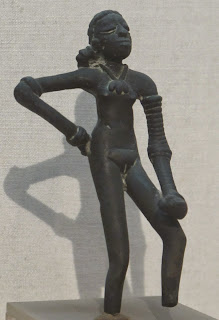Bangles can be traced back to 2600 BC, when a figurine of a
dancing girl with bangles on her arm was excavated from the Mohenjo-daro
ruins. Apart from this, numerous excavations of Indus Valley sites in Sind, Punjab and Gujarat have yielded bangles of shellac, clay and metal.
In Hindu and Sikh weddings in Punjab, the bride is gifted red-and-white bangles to wear on her wedding
day. There is a ceremony, the chuda ceremony, which is on the day before the wedding, or on the actual wedding day itself. Traditionally, 21 bangles are gifted, although these days brides sometimes wear fewer bangles.
Originally ivory-made, white bangles are now made in plastic. There are few things more picturesque
than an Indian bride dressed up to her eyes in the traditional shades of
red and white. And the red and white choora (bangles) do much to
compliment the bride.
The bride wears the bangles as a
sign of being newly married. The bangles are made of delicate materials, so that
the bride is exempt from any heavy household chores. After the wedding, the bangles are traditionally worn for a year. In modern times, this too has reduced to 40 days. Nevertheless, the tradition of bangle-wearing lives on and is quite delightful
to behold.




Nice post, Yes In Hindu culture bridal bangles plays very vital role after marriage.
ReplyDeletenice post
ReplyDelete